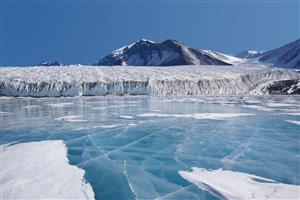
Antarctic place names recognise 'modern explorers'
03/12/2020
Línea Verde
info@lineaverdemunicipal.com
Antarctica is getting 28 new place names to recognise British individuals who've made a major contribution to advancing science in the polar regions. The list includes Jonathan Shanklin, co-discoverer of the ozone hole, and Alastair Fothergill, whose BBC films such as Frozen Planet have widened understanding of the White Continent.
The honourees will be associated with various mountains, glaciers and bays. These are features known previously only by their anonymous coordinates. It's highly unusual for so large a group of people to be recognised in this way all at once. But the UK Antarctic Place-names Committee felt something special was required to mark the 200th anniversary of the discovery of the continent.
- Attenborough polar ship leaves construction yard
- Antarctic glaciers to honour 'satellite heroes'
Russian explorer Fabian von Bellingshausen and British/Irish naval officer Edward Bransfield first sighted Antarctica within days of each other in January 1820. They, of course, have long had their names printed on maps of the polar south - as have those famous figures from the later "Heroic Age" of Antarctic exploration, such as Roald Amundsen and Robert Falcon Scott.
Committee secretary Dr Adrian Fox said the newly recognised individuals could be just as proud of their achievements. "If you look at the existing names in the Antarctic Gazetteer, they are a shorthand for the history of exploration and scientific endeavour. This latest group of names will add to that history. And when future generations look back, they'll understand what the science priorities, and operational focus, were at the time", he told BBC News.
Dr Shanklin, along with Joe Farman and Brian Gardiner, alerted the world in 1985 to the deep thinning that was occurring in the ozone layer above Antarctica each spring. The team's discovery led to the Montreal Protocol that banned the industrial and household chemicals responsible for the damage. Dr Shanklin is having a glacier on the Antarctic Peninsula named after him.
"We're a different sort of explorer today", he said. "Whereas in the past they were exploring terra incognita, modern scientists are exploring the environment in its broadest sense - the changing climate, the changing ice sheets, the changing ozone hole. And all this points in the same direction - that we're doing substantial damage to our planet".
Among those recognised are seven pioneering women. Dame Prof Jane Francis is the current director of the British Antarctic Survey. But she is also an expert palaeoclimatologist, specialising in the study of fossil plants. She's helped reveal how Antarctica had periods of considerable warmth in the geological past. Her name will be attached to a 1,136m-high peak that is surrounded by imposing cliffs.
Prof Helen Fricker has been a leading light in the use of satellites in the Antarctic, showing how great floods of water can move beneath the ice sheet. Maps will now feature the Fricker Ice Piedmont. A piedmont is an amalgam of ice from different glaciers that have joined together at lower elevation.
The co-lead at the Scripps Institution of Oceanography's Polar Center told BBC News: "This was unexpected and feels a little weird but I am deeply honoured, especially to be included alongside my mentor/friend Seymour Laxon, and Katharine Giles. I've never been to the Antarctic Peninsula and would love to go there sometime, hopefully by boat". Laxon and Giles were co-workers at University College London who made significant advances in the satellite measurement of sea-ice. The pair died within months of each other in 2013 - the result of tragic accidents. The UCL team will now be memorialised at two bays in the northwest of the Peninsula.
The new names will feature on all British maps, charts and publications; and they are also being put up to the Scientific Committee on Antarctic Research (SCAR) for inclusion in its international directory, or gazetteer. This should lead to all other nations using the names, too. Safe operations on the remote continent require that there is no confusion over what a location is called during an emergency, so there is an imperative to adopt common terminology. The full list of 28 names, with profiles, can be found on the British Antarctic Survey website.
Jonathan Amos / BBC NEWS

Environmental news
- What is COP28 in Dubai and why is it important?
- Climate change: How is my country doing on tackling it?
- COP27: Why the latest UN climate conference matters
- New oil and gas at odds with green goals - report
- World's biggest plant discovered off Australian coast
- Hubble: 'Single star' detected at record-breaking distance
- James Webb telescope parked in observing position
- Brexit paves the way for gene-edited crops
- Venus: Nasa announces two new missions
- Nature: Throwing money at biodiversity schemes is ineffective
- UK woodlands 'at crisis point' amid wildlife decline
- Nasa Mars rover: The clanking sound of Perseverance's wheels
- Climate change: 'Exceptionally hot' 2020 concludes warmest decade
- 'World's ugliest orchid' tops list of new discoveries
- Antarctic place names recognise 'modern explorers'
Cerrar [X]Uso de cookies
Utilizamos cookies propias y de terceros para mejorar nuestros servicios y recopilar datos estadísticos sobre hábitos de navegación. El uso de cookies es necesario para la notificación de incidencias. Si continúa navegando, consideramos que acepta su uso. Puede obtener más información, o bien conocer cómo cambiar la configuración, en nuestra Política de cookies




